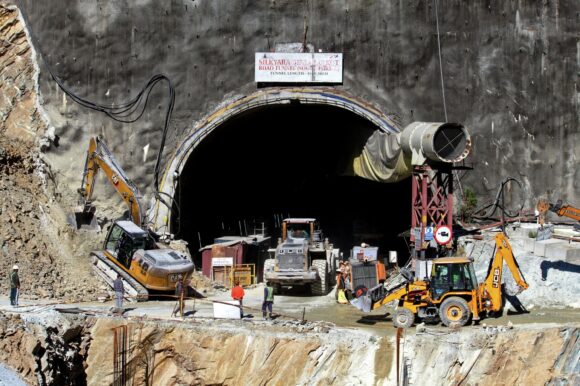For nearly a week, 40 workers have been trapped in an under-construction tunnel after a landslide demolished its entrance, derailing a major connectivity development in India’s mountainous state of Uttarakhand.
Since Nov. 12, rescue teams have employed a slew of strategies to open a passage through the 40-meter blockage, including attempting to insert wide pipes for the workers to crawl out of the rubble. According to local authorities, the laborers have received oxygen, food and water through a pipe and remain responsive.
The flagship Char Dham highway program, of which the tunnel is a main segment, will stretch for nearly 900 kilometers speeding up the journey of tourists and pilgrims visiting the local Hindu temples.
The accident, the latest in a series of disasters occurred in the past few years in the Himalayan state, highlights the dangers of building in the geologically sensitive area. Critics says such incidents are made more frequent and severe by dams, roads and other large infrastructure being built across the area.
In January, the holy town of Joshimath — a popular pilgrimage destination in the state — had to be partially evacuated due to a sudden worsening of its subsidence problem, with cracked walls and roofs putting many homes at risk of collapse. Building works for the Char Dham project had to be halted and experts blamed unfettered development for the situation.
The Himalayas are the planet’s youngest mountain range, and their seismic activity remains high because in geological terms they are still growing. Due to its impervious terrain and diverse geology, it is difficult to estimate how much weight an area can safely support, which is key to plan large infrastructure and urban expansion.
Catering to the development needs of one of the world’s most populous mountain states means that authorities in Uttarakhand are often tearing down forests and clearing grassland. But the natural ecosystem helps mitigate environmental shocks, and with fewer trees to strengthen the ground with their roots and reduce the impacts of heavy winds and rain with their foliage, the risk of landslides increases.
“The infrastructure development in fragile Himalayan ecosystems needs to integrate hyper-granular risk assessments to identify, map, and determine the impact of large infrastructures and it should be a national imperative,” according to Abinash Mohanty, sector head for climate change and sustainability with the consultancy IPE-Global.
The risks of large scale development are compounded by climate change, which scientists say is warming the Himalayas much faster than the rest of the planet. This will alter the hydrology and micro-climate of the region leading to increased precipitation and higher likelihood of glacial lake outburst floods, or GLOFs, which occur when a lake contained by a glacier suddenly bursts with devastating impacts downstream. The most recent GLOF event killed 18 people in the northeastern state of Sikkim in October.
Several studies have pointed out that much of the agricultural and infrastructure planning across India, and in particular in the vulnerable Himalayas, involves looking at historical ecological and weather data, which may not be an accurate way of gauging a future under climate change. As the government moves ahead with ambitious development plans to lift mountain communities out of poverty, with every new disaster the controversy over lack of environmental planning is bound to resurface.
Photograph: Rescue workers stand at an entrance of the under construction road tunnel, days after it collapsed in the Uttarkashi district of India’s Uttarakhand state on Nov. 18, 2023. Photo credit: AFP/Getty Images
Topics Construction
Was this article valuable?
Here are more articles you may enjoy.



 ‘Extremely Dangerous’ Hurricane Beryl Takes Aim at Caribbean
‘Extremely Dangerous’ Hurricane Beryl Takes Aim at Caribbean  German Insurtech Wefox to Replace CEO After Board Rejects Mubadala Sales Plan
German Insurtech Wefox to Replace CEO After Board Rejects Mubadala Sales Plan  Allstate, Nationwide Post Dramatic Q12024 Homeowners Loss Ratio Drops: S&P
Allstate, Nationwide Post Dramatic Q12024 Homeowners Loss Ratio Drops: S&P  GEICO Tops Progressive With Higher J.D. Power Scores
GEICO Tops Progressive With Higher J.D. Power Scores 

